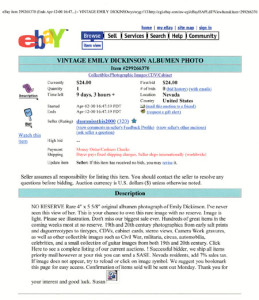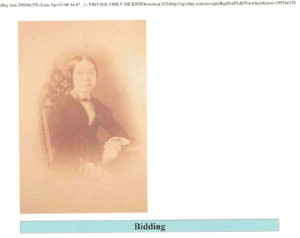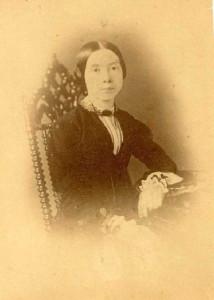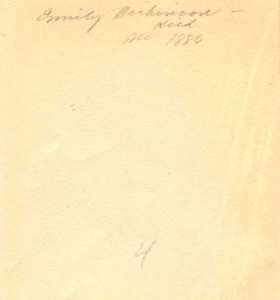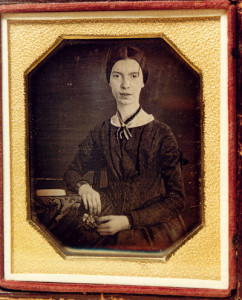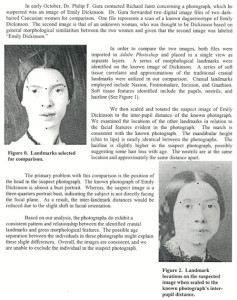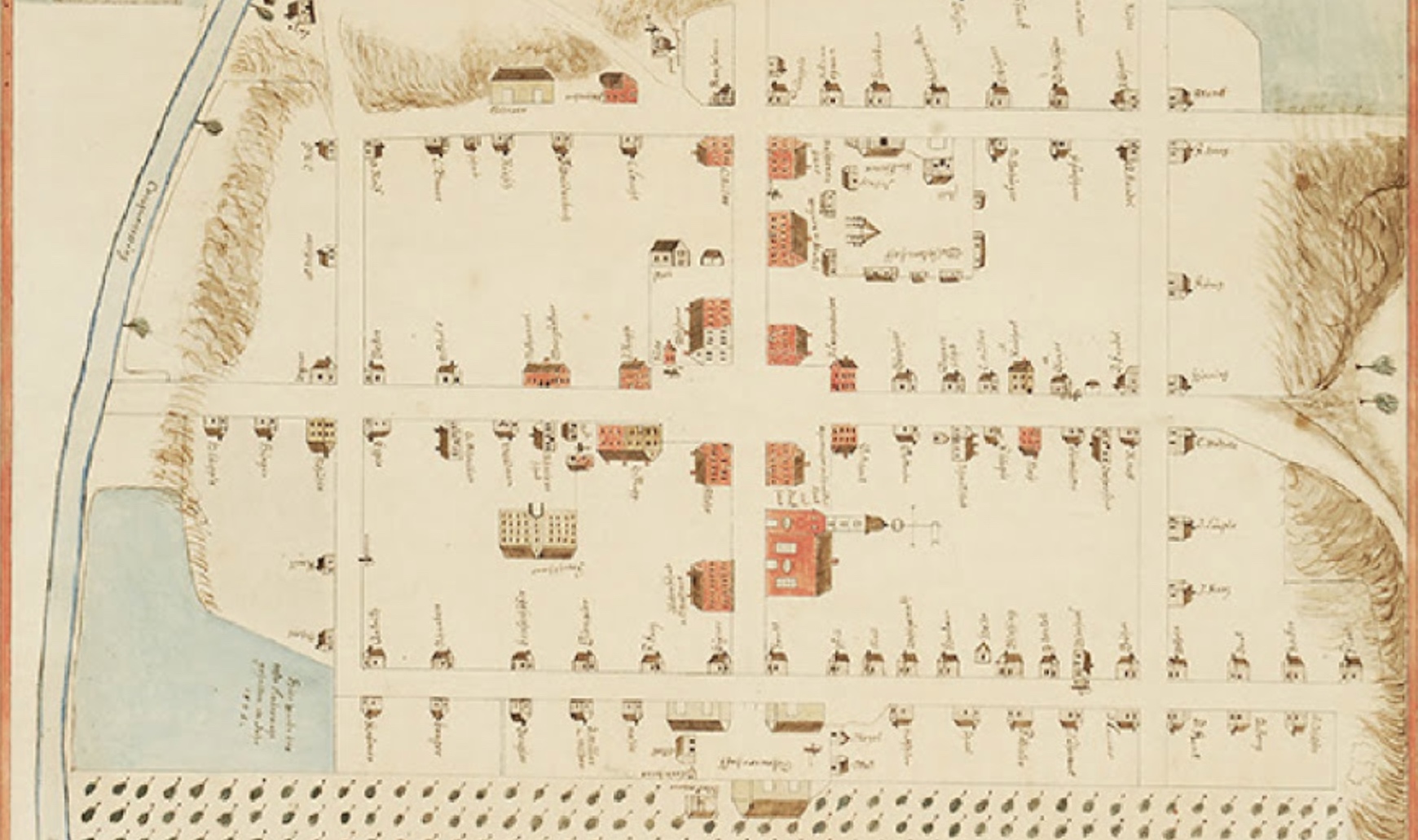This correction was sent to us as of June 19, 2009.
The fifth paragraph from the end of this essay (beginning, “Habegger and I posit…”) gives a misleading account of Professor Habegger’s position on the photograph as worked out in his biography of Dickinson, My Wars Are Laid Away in Books, and I would like to set the record straight. The impetus to do so comes from the tentative release of George Gleason’s report, prepared for the Emily Dickinson International Society, which repeats the mistake and develops it.
Professor Habegger did not say and does not believe that Dickinson had her photo taken in Philadelphia, let alone that she already felt affection for Charles Wadsworth and wished to commemorate it. He clearly states his position on p. 330 of his biography: “Although the sequence of events will no doubt always be obscure, it is thought that Dickinson was taken to the Arch Street Presbyterian Church to hear [this minister], and that he made such an impression on her that she later solicited his counsel and thus initiated one of her most vital friendships.”
I first prepared this piece for an invited oral presentation, at a time when I was working on someone other than Dickinson. Thinking back to when Professor Habegger and I were excited by the possibility that the photo was of Dickinson, in this lecture I incorrectly assumed that his view was the same as mine. Clearly, until further evidence surfaces, his position is the most sensible to assume.
This is the story of how I stumbled on something rare almost beyond comprehension. On April 12, 2000, I purchased in an eBay online auction what may be the second known photograph of Emily Dickinson. In the last ten seconds of the eBay auction I placed a very high maximum bid on what was called a “Vintage Emily Dickinson Albumen Photo” and won the item far below that amount. But the story had only begun. Over the next six months I experienced what it really meant to possess, and be possessed by, a picture that may show Emily Dickinson at the height of her creative powers.
You probably have a minds-eye picture of Emily Dickinson. Even people who do not read Dickinson’s verse recognize her as the diminutive woman in white who in the last decade of her life never left her yard nor greeted any visitors to her family’s home, and who at her death left a trunk filled with manuscript poems that changed America’s literary landscape. But a chief part of her mystery involves the fact that very few images of her survive. There is a painting of Dickinson and her two siblings done by A. O. Bullard in 1840, and a silhouette by Charles Temple in 1845. And even though she lived when the new invention of photography was changing the ways people thought about themselves, there is only one known photographic likeness of her, taken by William C. North. It was made between December 1846 and March 1847, and shows a thin teenager suffering from what her family took as the first symptoms of tuberculosis.
A second photograph of Dickinson has long been the Holy Grail of artifacts for scholars in my field, but it certainly was not on my mind the night that I first saw the image on eBay. I was browsing through the descriptions of albumen photographs, in search of images of stringed instrument players and of twins, two categories in which I collect. When I saw “Vintage Emily Dickinson Albumen Photo,” I laughed: another unenlightened dealer who didn’t realize that there were no albumen photos of the poet.
There was, after all, only the famous daguerreotype. For a kick I clicked on the description and viewed the item. I couldn’t believe it. The woman in the image, though a bit older than Dickinson as she sits in the daguerreotype of 1846-1847, bore an uncanny resemblance to the poet’s younger self.
The description was minimal and indicated that the seller–who had an on-screen cognomen, “dontmissthis2000″–had no clue that there was only one extant image of Dickinson. “NO RESERVE Rare 4 X 5 5/8in. original albumen photograph of Emily Dickinson. I’ve never seen this view of her. This is your chance to own this rare image with no reserve. Image is light. Please see illustration.” The minimum bid was a paltry $24.00, and the item was listed for ten days, a time that soon seemed interminable.
Over those ten days I returned to the image dozens of times. I wrote the seller to ask how she knew it was Dickinson, and she replied that the person was so identified by writing in pencil on the back. This was important, for it meant that the seller hadn’t just made up the description without any evidence, something that happens frequently on eBay with, say, purported photos of Lincoln or John Brown. Days passed. No one bid on the photo. I didn’t know what to do. I thought, on the one hand, that the item was simply and patently a fake, or, on the other, that it was going unnoticed as collectors chased more spectacular, and probable, pieces.
Then, on the second to the last day, someone bid, and I recognized the screen name as that of the late Robert Lucas, a well-known dealer in Dickinsoniana. This pushed me into deciding to purchase it, for I figured that if he, with a good nose for rarities, was in on this, there was a good chance that the photograph was real. But Lucas’s entry into the game also complicated matters immensely, for I knew that he might bid a substantial sum. Early in the evening on the night that the auction closed, I decided what amount I would risk. With ten seconds left I entered the bid, and the final price shot up to $481.00, $5.00 above Bob Lucas’ maximum bid. I had won! Within seconds he graciously emailed to congratulate me. He said that he thought it looked like her but was not willing to take a bigger risk.
The wait for the item seemed endless, but I finally received it nine days later. It looked good. From the type of paper and the quality of the image, I could tell that it was an unmounted albumen photo, clearly not a facsimile.
On the back was written: “Emily Dickinson / Died / D[?]ec. 1886” and below that there was a large number, “4.”
Now the work began in earnest. Consulting with Lucas, Polly Longsworth (a Dickinson biographer who early on believed that the photograph might be Dickinson), and other people who had seen the image after I posted it on my Website, I focused on three things to investigate. First, I sought to identify the handwriting on the back, for if I could show that it belonged to someone who knew Dickinson, it would offer strong circumstantial evidence. Second, I would try to trace the distinctive Gothic chair in the photo to some photographer’s studio and then find out if Dickinson had ever visited the area in which the person worked. Finally, I would enlist a forensic anthropologist to compare the features of the woman in my image to those of Dickinson in the famous daguerreotype.
Soon enough, however, I learned how skeptical many scholars were that my picture could be genuine. One email sums up what I encountered. “To the naked eye,” the individual wrote, “it is indeed a persuasive portrait, and one which I personally would love to see authenticated as a portrait of ED.” “As an aside, though,” he continued, “if it could be authenticated . . . I’d predict that many, many people might react with irrational denial, vituperation, or both. The daguerreotype has become such an icon, an object of near veneration, for so long, that a ‘new’ image of ED might take some time for people to get used to.” For a century, Dickinson’s admirers had treasured the one extant daguerreotype and raised it to iconic status. Most would not readily accept the possibility that, after all these years, another image had surfaced.
Soon the nature of the game changed radically, though, because, alerted by members of the Emily Dickinson International Society, more and more people began to view the picture. Then I got a call from a stringer for the New York Times who wanted to write up my picture for the “Circuits” section of that paper. And the next day I got this message by email: “Dear Mr. Gura, I am David Remnick, editor of The New Yorker magazine, and Bob Faggen from Claremont has told me about the fascinating Dickinson picture. I was wondering if we could talk: I am interested in publishing it here first, if at all possible. Please let me know if I am dreaming or if there is a chance.” I jumped at the chance to have the image appear in so important a publication. Faggen teaches American literature at Claremont. Alerted via the Dickinson Society Listserv, he had seen the image on my site and called his old friend Remnick. When I returned Remnick’s message I told him that the Times had called, too; and he said that he was only interested in publishing the photo if he could be the first to do so. So I called the Times stringer and asked her what her plans were. She was not going to do the piece for the next weekly “Circuits” but for the installment ten days hence.
Remnick pounced. He put staff writer Rebecca Mead on the assignment. This was a Wednesday. She said we had to wrap up the story the next day because the magazine went to press on the weekend, to be on the stands the following Monday. And she did it, talking to me several times, calling several other people, including the seller, Janos Novomeszky, whom she tracked down in Budapest, where he had gone for his father’s funeral; and Steve White, a California dealer who had let the photo slip through his hands into Novomeszky’s. Mead’s piece, in the May 22, 2000, “Talk of the Town,” was called “Annals of eBay: A New Kodak Moment with Emily Dickinson,” and ran with my new photo next to the Amherst College daguerreotype.
This opened the gates to national publicity. Within days I was interviewed by NPR affiliates and newspapers in the Amherst area. Stories about Emily and me popped up in many papers, including the online magazine Slate and London Observer, attention that increased when the New York Times piece appeared a week later. I had hundreds of hits on my Website and many unsolicited emails, in which people asked for more information and often confessed their various passions, scholarly and otherwise, for Dickinson.
As weeks passed, though, the photograph became an albatross around my neck. Everywhere I went people asked how I was getting along with my verification work. And I wasn’t getting anywhere. Most troubling was the matter of the forensic analysis, in which many scholars placed much stock because in the 1970s a photo also presumed to be Dickinson proved spurious, a bookseller’s scam. And that was before the Digital Age, which made copies and originals all but indistinguishable. Some cognoscenti were very skeptical of my image. They wanted the photograph compared to the Amherst daguerreotype.
And so I proceeded, from literature to journalism to science. I first contacted the scientist who had analyzed the spurious photo from the 1970s; but she said that she no longer was doing that kind of work. She referred me to someone in Texas who initially seemed very interested in the project and said that, after she returned from giving a two-week seminar to law-enforcement personnel in Arizona she would take up the task. But when I wrote to her after the seminar had ended, she never answered any more of my emails and calls. A month or so had passed. I called Grant Romer, the curator at the George Eastman House. He said that he had just the man for me, a forensic anthropologist at the University of Illinois at Chicago. I contacted this individual, and he said that he could have a report for me after the Fourth of July weekend, when I was due to travel to New England and wanted to share his results with people who would be interested. But he, too, never again responded to any emails or phone messages! What was it about this project that had frightened them off? And what was I going to do about the analysis, particularly since my research inquiries about the chair had brought nothing to light, and my attempts at identifying the handwriting showed that it belonged to no one in Dickinson’s immediate circle?
Not everything went badly, though. Over the summer I had established that my photograph in fact was a copy of a daguerreotype made years earlier. In retrospect, I should have seen what was obvious; but I did not realize it until Joan Severa, a historian of costume, analyzed the sitter’s clothes and concluded that they dated to the late 1840s or early 1850s, not to the period of cabinet cards. Another historian of costume dated the piece even more precisely. Nancy Rexford observed that the sitter’s jacket-style bodice was very common in the early 1850s. Similarly, the collar of the woman’s chemisette is typical of the period 1848-52, as are the narrow undersleeves. Finally, the bodice sleeves appear to form a narrow bell or funnel; after 1853 they became more expansive. In Rexford’s opinion, the original photograph was a daguerreotype taken around 1850-52, and perhaps as late as 1853. Putting Rexford’s opinion alongside Severa’s, and considering that some individuals wear clothing even after it is out of fashion (something that we might expect of Dickinson) the evidence from costume suggests that this person sat for her photograph sometime between 1848 and 1853.
I had, then, a photograph made after the mid-1860s (when the albumen process was common) but also patently a copy of an earlier image, a daguerreotype, a medium used primarily between 1839 and 1857. This is also signaled by the washed out appearance near the extremities of the image, a result, as one photohistorian puts it, “of glare from the silvered mirror surface” of the daguerreotype being copied. Also, the photograph has small spots or bubbles characteristic of the deterioration to which daguerreotypes are prone from decomposition of chemicals on the surface of the polished silver plates on which they are made. Most tellingly, the sitter’s right hand appears to have two index fingers, a visual effect that would have been recorded in a daguerreotype if a sitter moved her hand in some way over the exposure time of a few seconds demanded by the process.
With the development of the albumen process, photographers had begun to advertise their services as copiers of earlier, unique images like the daguerreotype and ambrotype. Thus, the unusual number “4” on the verso may indicate that whoever made this image produced at least that number of copies from the original daguerreotype. Further, on the verso there are remains of glue, which suggests that the original photograph was mounted, probably on cardstock known as “photographer’s board.” In this mounted state the albumen photograph would have been called a “cabinet card,” for its dimensions are precisely those of this format, introduced in this country around the middle-1860s and reaching a height of popularity in the 1880s and 1890s. Inexpensive and of a larger size than cartes de visites, cabinet card-sized photographs, easily reproduced from negatives, comprised some of the most common mementos in Victorian America.
There matters lay through most of the summer and early fall, when I was contacted by Georgie Strickland, editor of the EDIS Newsletter, who wanted to write up the story for her journal and asked if I had made any progress on the forensic analysis. When I described my woes, she called Joe Nickell, the author of Camera Clues: A Handbook for Photographic Investigation. Through his contacts I obtained the names of two scholars at the Forensic Anthropology Center at the University of Tennessee, where the woman who had analyzed the previous, spurious photo had worked. One of them, Professor Richard Jantz, wrote back and said that he had a student who was particularly interested in such work and, yes, please send the files, for the two of them would do it together.
I had gotten to this point twice before and held my breath. I knew what I might expect and how the scientists’ language would be couched. Such forensic analysis proceeds by mathematical comparisons of anatomical landmarks on the authenticated image and the image in question. While such methods cannot establish absolutely that two images portray the same person, a comparison to a known image of one that is unknown can go a long way toward establishing a strong case that the two images are or are not congruent. In this case Dr. Jantz identified several key points–centers of eyes, nostrils, corners of mouth, for example, and overlaid and adjusted the images to a common size.
I got his email on October 13, six months to the day since I had bought the photo, and on Friday the Thirteenth! In this case, he wrote, “[T]he fit is quite good” and thus, to use the language of scientists, the new photo “could not be excluded” from consideration as that of Dickinson. He continued, “[T]he fit is actually pretty impressive and perhaps makes the case [for their being of the same person] well enough.” In a subsequent interview, he went even further. “If it’s not Emily, it’s a person with a very similar morphology,” he said. “I think the case will always be circumstantial, but a strong circumstantial case is a strong case.” This was great news, for it finally enabled me to say that, taking into account circumstantial evidence–i.e., the handwritten identification as well as this report (for what would the chances be that someone could find a photo to forge that lined up precisely this way with the well-known daguerreotype?)–there was strong reason to think that this might indeed be the second known photograph of Dickinson. The full report followed, and it was indeed positive, as were follow-up conversations with Dr. Jantz initiated by news agencies. The publicity buzz was on again as the story got picked up on October 25 by the Associated Press and salon.com, and then in U.S. News and World Report.
With the aid of Professor Alfred Habegger, soon to publish a new biography of Dickinson, I also pieced together some biographical data that spoke to the possible relationship between the two images. In the Amherst daguerreotype, Dickinson’s face appears much thinner than that of the woman in the albumen. We know, however, that through the late 1840s, when that image was made, Dickinson’s health had been fragile; her persistent cough may have been a consumptive condition that also made her family worry about her weight loss. Through the summer of 1851 her letters to her brother Austin, teaching school in Boston, mention family illness, and as late as July 1851 she lamented that she could not make a long-anticipated trip to see him.
By September, however, the family had consulted with the eminent Boston physician, Dr. James Jackson, who prescribed doses of glycerin to control the cough; and within a month Dickinson, though not fully recovered, evidently was feeling better. In a note that her sister Lavinia included with a letter from Emily to her brother, she observed that “Emily is very much improved.” Indeed, she continued, “she has really grown quite fat, if youll believe it.” “I am very strict with her,” Lavinia added, and “I shouldn’t wonder if she should come out bright some time after all.” If the Amherst college daguerreotype represents a Dickinson whose health worried her family, the original of the albumen, taken in the early 1850s, shows a woman whose appearance is congruent with someone whose health had indeed improved and who had become a little “fat.” I also returned to an enigmatic passage in Dickinson’s famous 1862 letter to Thomas Wentworth Higginson, editor of the Atlantic Monthly and a confidant of the poet, which some scholars read as proof that she had no other photographic image of herself. As she put it,
Could you believe me–without? I had no portrait, now, but am small, like the Wren, and my Hair is bold, like the Chestnut Bur–and my Eyes, like the Sherry in the Glass, that the guest leaves–Would this do just as well?
It often alarms Father–He says Death might occur, and he has Molds of all the rest–but has no Mold of me, but I noticed the Quick wore off those things, in a few days, and forestall the dishonor–You will think no caprice of me.
Dickinson’s declaration, “I had no portrait, now,” is ambiguous at best. For one thing, if she meant that she never had one, she might have simply replied, “I never have had one, not before, not now.” But if she meant to say, “I have no portrait, now,” she could mean that she once had an image but no longer did, either because it was given away or it did not represent her as she was “now.” In any case, as it stands, the line does not necessarily imply that she never had had a portrait taken. Indeed, we know that at least once she did, in 1846-1847 when an itinerant daguerreotypist made the image now owned by Amherst College. At the least, Dickinson’s enigmatic reply to Higginson refers to a time when she did have a portrait, which for some reason she no longer had. It could have been the 1846-1847 image, or even the original of the one in the albumen photograph.
If we grant this possibility, who might have had the original daguerreotype, and who made the paper copy and why? I returned to the handwriting. Attempts to identify it had ruled out individuals in Dickinson’s circle of family and friends in the Springfield-Northampton-Amherst area. This is congruent with Elizabeth Bernhard’s observation that, as Dickinson’s fame increased in the 1890s, family and friends in the Amherst area went to great lengths to find another photograph of her, suitable as a frontispiece to her forthcoming Letters. They found none save the now-famous Amherst College daguerreotype that had been given to Dickinson’s housekeeper, Margaret Maher, an image they did not like. Quite likely, then, the albumen photograph (and the daguerreotype from which it was made, as well as any other copies) lay outside the Springfield-Amherst-Northampton axis, perhaps given to a friend who had moved from the area long before Dickinson became famous.
Habegger and I posit the following scenario, outlined in detail in an appendix to his biography. The supposition involves Charles Wadsworth, the charismatic clergyman whom Dickinson met in Philadelphia in 1855 and who many think may have been the recipient of her famous letters to her mysterious “Master,” as she called him. The original of the image could have been made for him on Dickinson’s visit to his city. We know, for example, that the invention of photography provided new, very personal tokens of friendship and affection to a culture awash in varieties of such expression. It is plausible that a young woman might visit one of the city’s prominent daguerreian studios to memorialize her feelings for a man who we know remained central to her emotional life as long as she lived.
Wadsworth died in 1882, but his wife lived until 1891. Before his death he may have sent the photograph to James D. Clark. James and his brother Charles were Northampton natives and contemporaries of Dickinson who began to correspond with her in the early 1880s. James had operated a private school in Brooklyn but by the 1870s had moved back to Northampton. His younger brother remained in Brooklyn and throughout his life was involved in business there. Dickinson had first met James in Amherst around 1859, but it was not until 1882 that she began to write to him and then, after his death in 1883, to Charles. When Dickinson heard from James in 1882, he was again in Brooklyn, getting help for failing health. He had initiated the correspondence by sending Dickinson a volume of sermons by Wadsworth, his close friend. In the early 1880s, as Wadsworth took stock of his life, he may have copied a daguerreotype Dickinson had given him years earlier and shared it with his friend. In an alternate scenario, after Dickinson’s death Wadsworth’s survivors may have forwarded the print to Charles (which he received in “Dec 1886,” as the pencil markings on the reverse of my photograph note), knowing of his and his brother’s relationship to her.
The question arises why, as Dickinson’s fame increased in the 1890s, when family and friends searched for a photograph, Charles (or someone in his family) did not offer his. But the Dickinsons had no reason to think that he would have had one, so recently had he begun his correspondence with the poet. Further, as James grew more ill, he may have enjoined Charles to silence on the matter, just as James may have been so enjoined by Wadsworth. From all we know, Wadsworth’s marriage was satisfactory. Neither he nor his family (if they knew of Dickinson’s strange attraction to him) would have wanted to have the infatuation known. Dickinson clearly meant enough to Wadsworth that he visited her, to see her for the third and last time, as late as 1880, after a twenty-year hiatus. Surely, James Clark was a close enough friend to keep his secret and thus to receive a copy of an image of the woman who had, whether or not Wadsworth wanted it, become a part of his life. Comparing the inscription on the photo to the one extant letter of Charles Clark reveals congruence among some letter forms, so much so that several people indeed believe it to be his hand. I myself am not yet fully convinced, for I see an important difference in one of the capital letters the two samples share. But if the handwriting is not Charles’s, it may be that of someone in his circle who upon Dickinson’s death in 1886 wrote the identification on the back of the photograph that had passed into his or her hands. A final possibility is that the daguerreotype was among Wadsworth’s keepsakes, and his wife or daughter Edith made copies and distributed them to friends or confidants who could be trusted to keep the family secret.
I (and many others) continue to believe that the image genuinely is of Dickinson, and my state of mind regarding it was beautifully summed up in an editorial about the image in the (Durham) Herald-Sun. “Although the forensic analysis of Gura’s photo strongly suggests the woman is ED,” the author noted, “no one can say for sure. By the same token, no one apparently can say that the woman is NOT Dickinson. Thus is Philip Gura caught in neutral buoyancy between belief and hope. Or, maybe that’s the way ED wanted.”
This expressly captures how I think about this photograph. I know it is she, even if I cannot yet absolutely prove it. If the image proves genuine beyond a doubt, I realize that I will have to find a home for it in some institution, for it then would belong in a new way to all people who love Dickinson’s poetry. Right now, however, I can look at this image every day and thus perhaps get as “close” to this elusive woman as anyone can. It is a delightful feeling.
Further Reading: See Mary Elizabeth Kromer Bernhard, “Lost and Found: Emily Dickinson’s Unknown Daguerrotypist,” New England Quarterly 72 (December 1999): 594-601; Alfred Habegger, My Wars Are Laid Away in Books: The Life of Emily Dickinson (New York, 2001); Jay Leyda, The Years and Hours of Emily Dickinson 2 vols. (New Haven, 1960); Rebecca Mead, “Annal of eBay: A New Kodak Moment with Emily Dickinson,” The New Yorker, 22 May 2000; Joe Nickell, “A Likeness of Emily?: The Investigation of a Questioned Photograph,” Emily Dickinson International Society Bulletin 5 (November/December 1993), 1-3, 15; Richard B. Sewall, The Life of Emily Dickinson (New York, 1974).
This article originally appeared in issue 4.2 (January, 2004).
Philip F. Gura is the William S. Newman Distinguished Professor of American Literature and Culture at the University of North Carolina at Chapel Hill. He has published widely in American studies, including, most recently, Buried from the World: Inside the Massachusetts State Prison, 1829-1831 (Boston, 2001) and C. F. Martin and His Guitars, 1796-1873 (Chapel Hill, 2003). A collector of early photography, he is a member of the Daguerreian Society.



